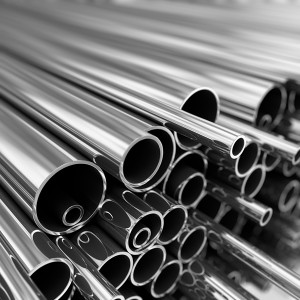
Seamless vs. welded tubing represent two different types of stainless steel tubing used in various industrial and commercial construction, structural, medical, and aesthetic applications. Therefore, choosing between seamless vs. welded tubing will depend on the product application requirements. Though seamless and welded stainless steel tubing are common forms of tubing, they differ in a number of ways. Users should be aware of these primary differences, including the following:
Manufacturing Process
Seamless stainless steel tubing is produced via an extrusion process where the tube is drawn from a solid billet of stainless steel and extruded into a hollow form. The billets are heated and formed into oblong circular molds which are hollowed in a piercing mill and then elongated through a mandrel milling technique while hot. Tubing is further shaped through pilgering, a cold rolling process, or cold drawing. This process produces a smooth, continuous, homogeneous surface with no welded seams. Seamless tubing is known for its uniformity, strength, and corrosion resistance, making it suitable for high-pressure and critical applications. The absence of weld seams eliminates the risk of weak points, making seamless tubing generally stronger and more resistant to pressure and corrosion.
As the name suggests, welded stainless steel tubing is made by rolling a flat strip of stainless steel into a tube shape and then welding the seam to join the edges. This welding process creates a strong, continuous tube with a longitudinal weld running along its length. Choice of a visible seam or weld bead on the interior and exterior of the tubing or worked smooth by cold rolling and forging methods. Welded tubing can be accomplished through hot forming and cold forming. Though both hot and cold methods create a durable, strong, steel tube that resists corrosion, cold forming offers smoother finishes with tighter tolerances.
Strength and Durability
Of the two processes, seamless tubing is generally considered to be stronger and more durable because it lacks the structural weaknesses that weld seams can introduce. It is often preferred for applications where high pressure or high-temperature conditions are involved. Welded tubing may have weaker concentration areas near the weld seams, advancements in welding technology have greatly improved the durability and quality of welded tubing. Nonetheless, it is potentially less suitable for use in construction projects that require extreme strength or pressure resistance.
Cost
One key advantage of welded tubing is it is typically more affordable and cost-effective. Seamless tubing is generally more expensive than welded tubing due to increased cost of production related to the time it takes to manufacture. It involves a number of steps such as heating, forming, machining, milling and so forth. Costs of seamless and welded tubing are also related to such properties as strength and durability. For example, welded tubing’s easier manufacturing process can produce larger diameter tubing with thinner wall sizes for less. Such properties are more difficult to produce in seamless tubing. Overall, welded tubing is a cost-effective choice for applications that do not require the extreme strength or corrosion resistance of seamless tubing.
Size and Availability
Welded tubing is available in a wider range of sizes, shapes, and dimensions, making it more versatile for various applications. In terms of ordering, welded tubing has faster lead times because its production process is faster and requires less time to manufacture. Seamless tubing may have limitations in terms of available sizes and dimensions, which could impact its suitability for certain applications.
Applications
Seamless tubing is ideal for high-pressure and high-temperature applications, such as in the petrochemical, oil and gas, and aerospace industries. It is generally used in applications where corrosion resistance is crucial, such as in chemical processing and food production. Welded stainless steel tubing is used in a broad range of applications, including structural components, automotive exhaust systems, handrails, medical devices, and many general-purpose plumbing and piping systems.
The choice between seamless and welded stainless steel tubing depends on the specific requirements of the application, with factors such as cost, strength, and corrosion resistance being key considerations. A number of factors combine to make stainless steel tubing an excellent choice for structural applications in industries ranging from automotive and aerospace to medical and marine. Seamless tubing is generally favored for high-performance, critical applications, while welded tubing is suitable for a wide range of general and cost-sensitive applications.
If you’re still unsure which tubing is best for your application, or if you have questions about a specific tubing, contact the experts at Atlantic Stainless today. We offer a wide variety of seamless and welded tubing to meet your application needs.

